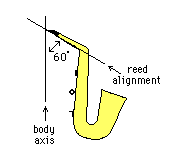 To maintain the optimum reed angle of 60° off the vertical on a straight soprano sax, the player must stretch the arms rather far from the body.
To maintain the optimum reed angle of 60° off the vertical on a straight soprano sax, the player must stretch the arms rather far from the body.
Bent soprano head joints are therefore available for most brands. This reduces the required stretch and relaxes the posture.
Preferred reed angles for the saxophone and for the clarinet are different.
The reed angle for optimum sound production on the clarinet is about 35° off the (vertical) body axis. The clarinet is therefore held much closer to the body than a soprano saxophone.
Never hold a soprano-sax like a clarinet and vice versa.
(Down - Up - Top)
SAX 2.4 - Wrists and Left Thumb